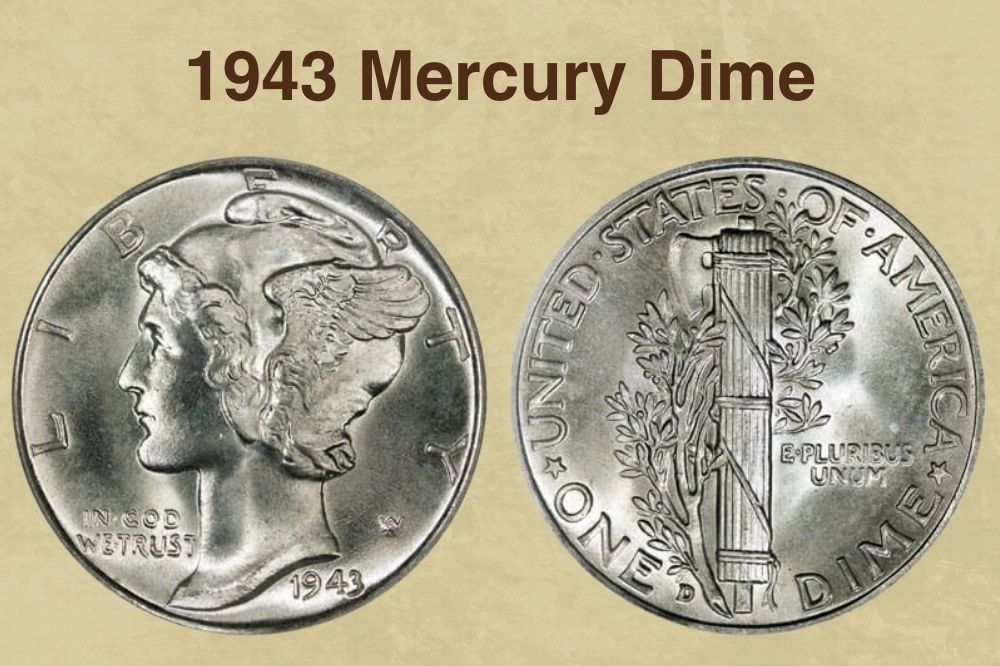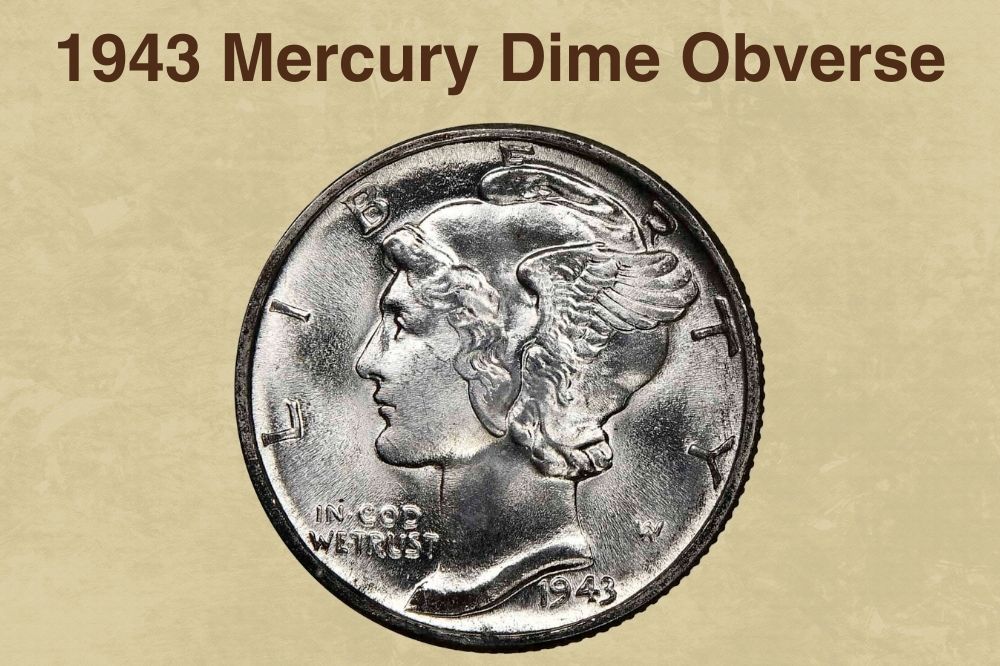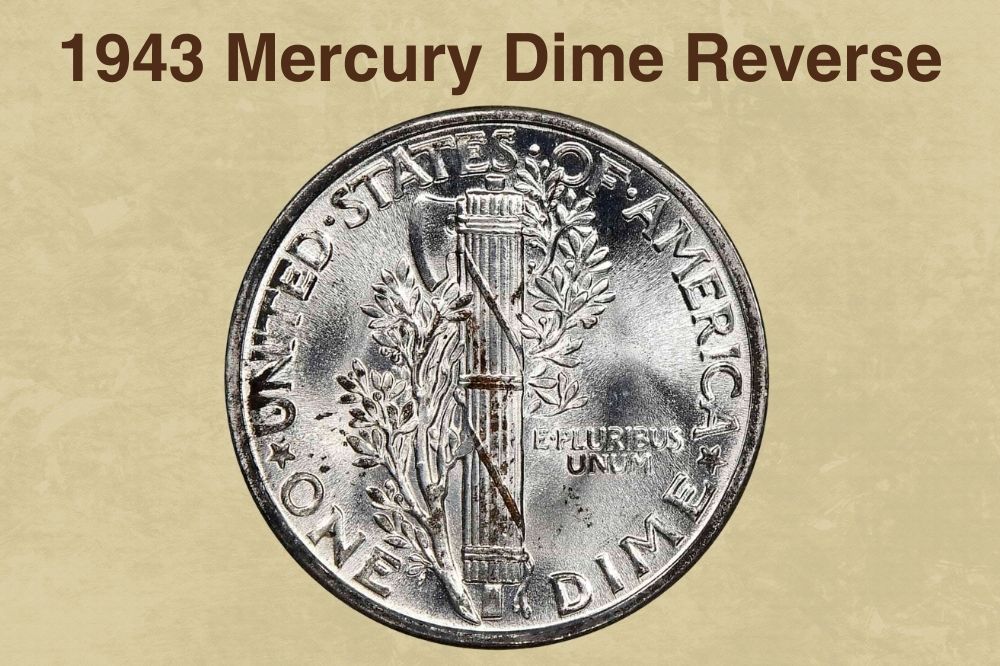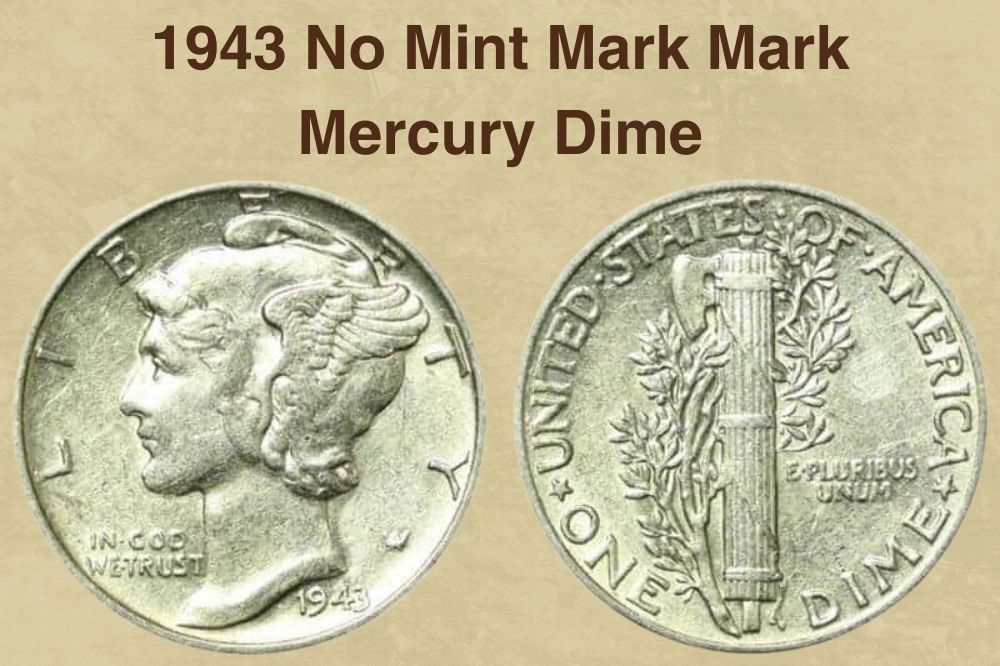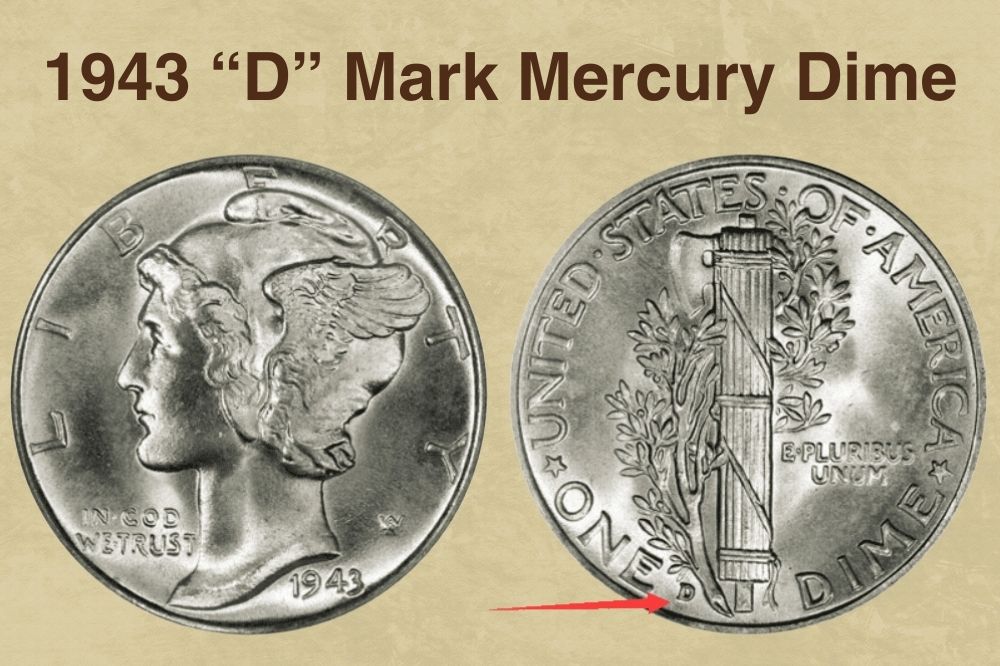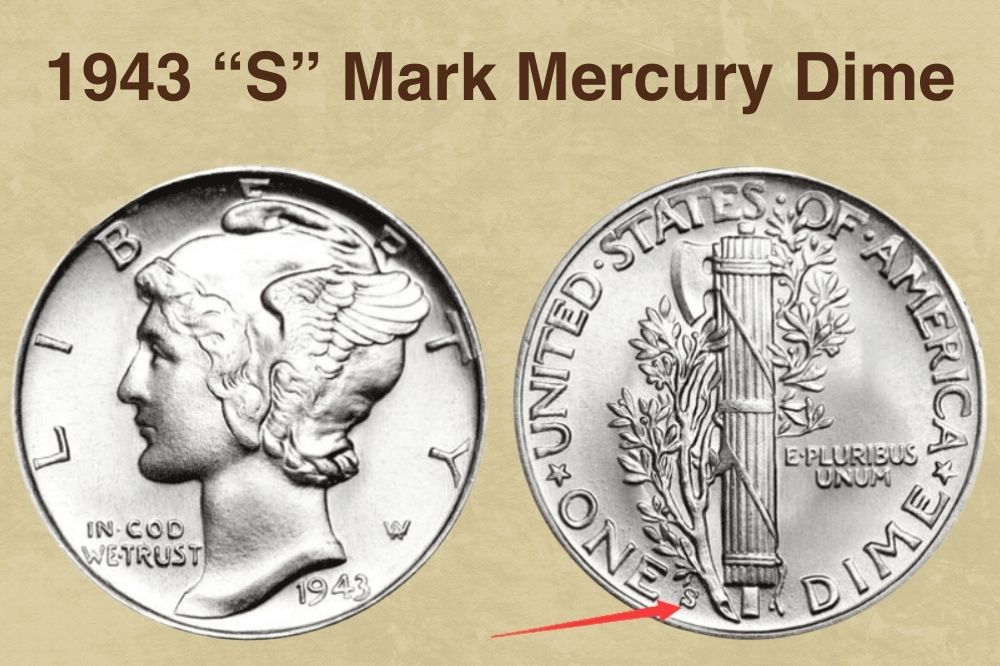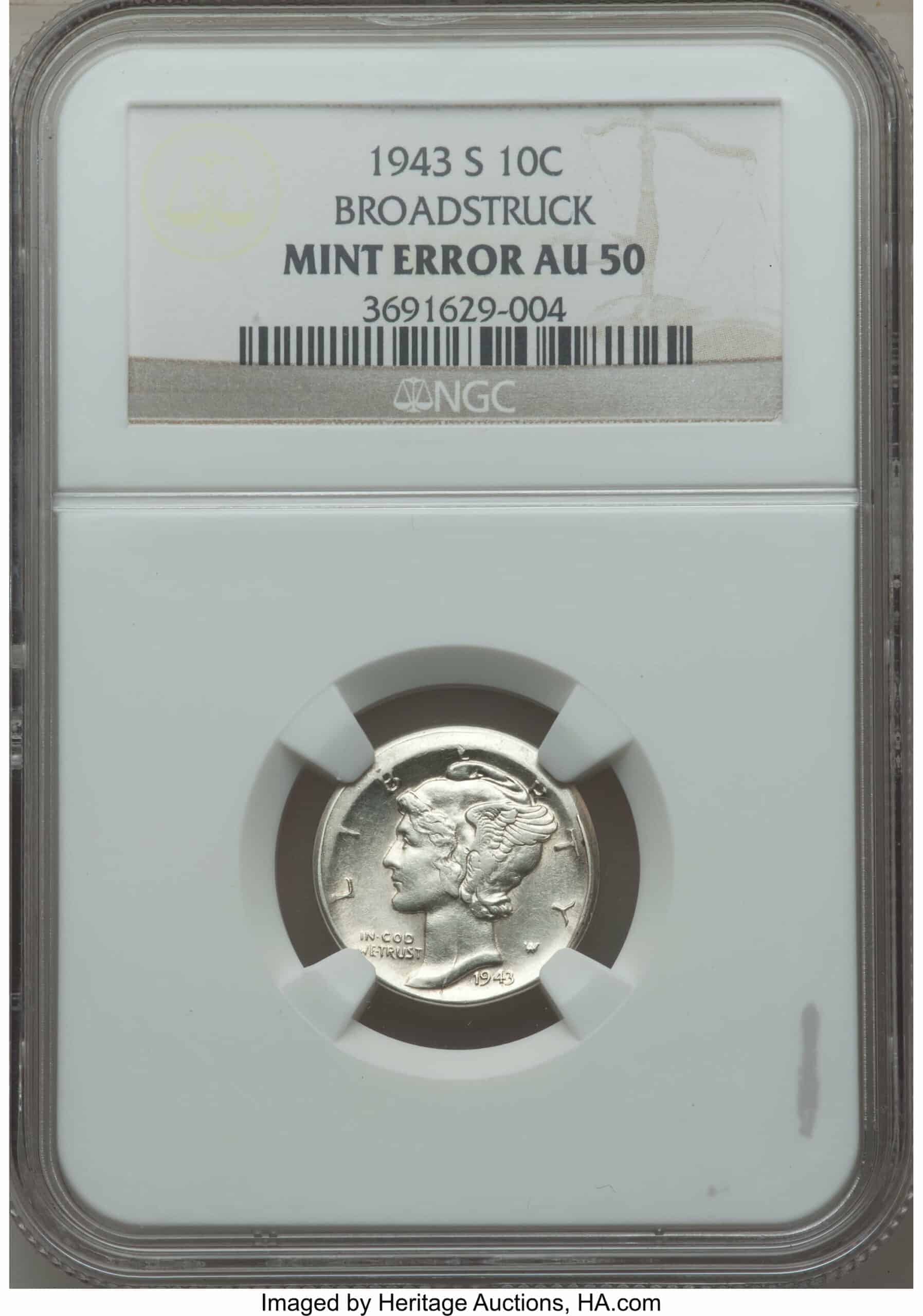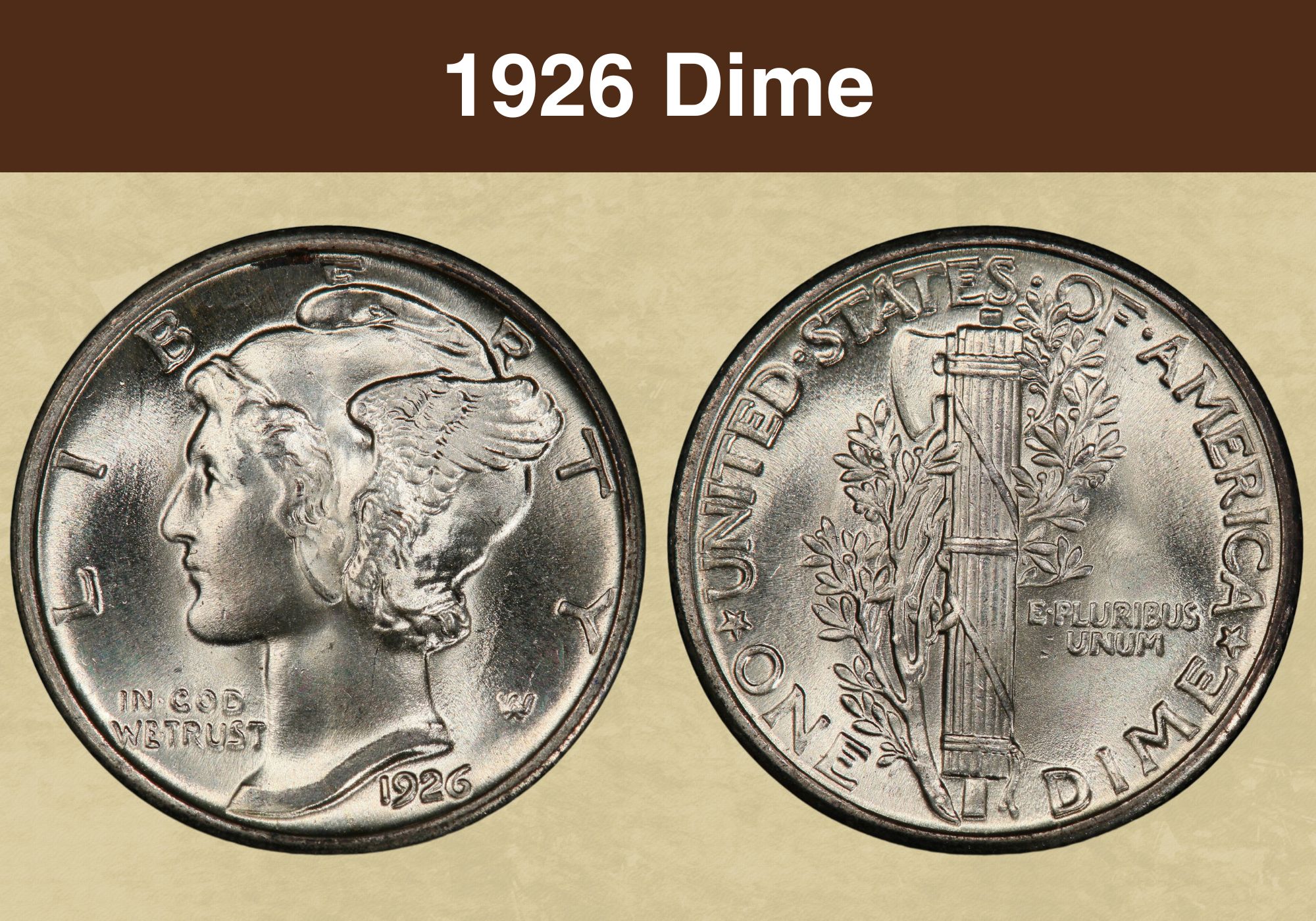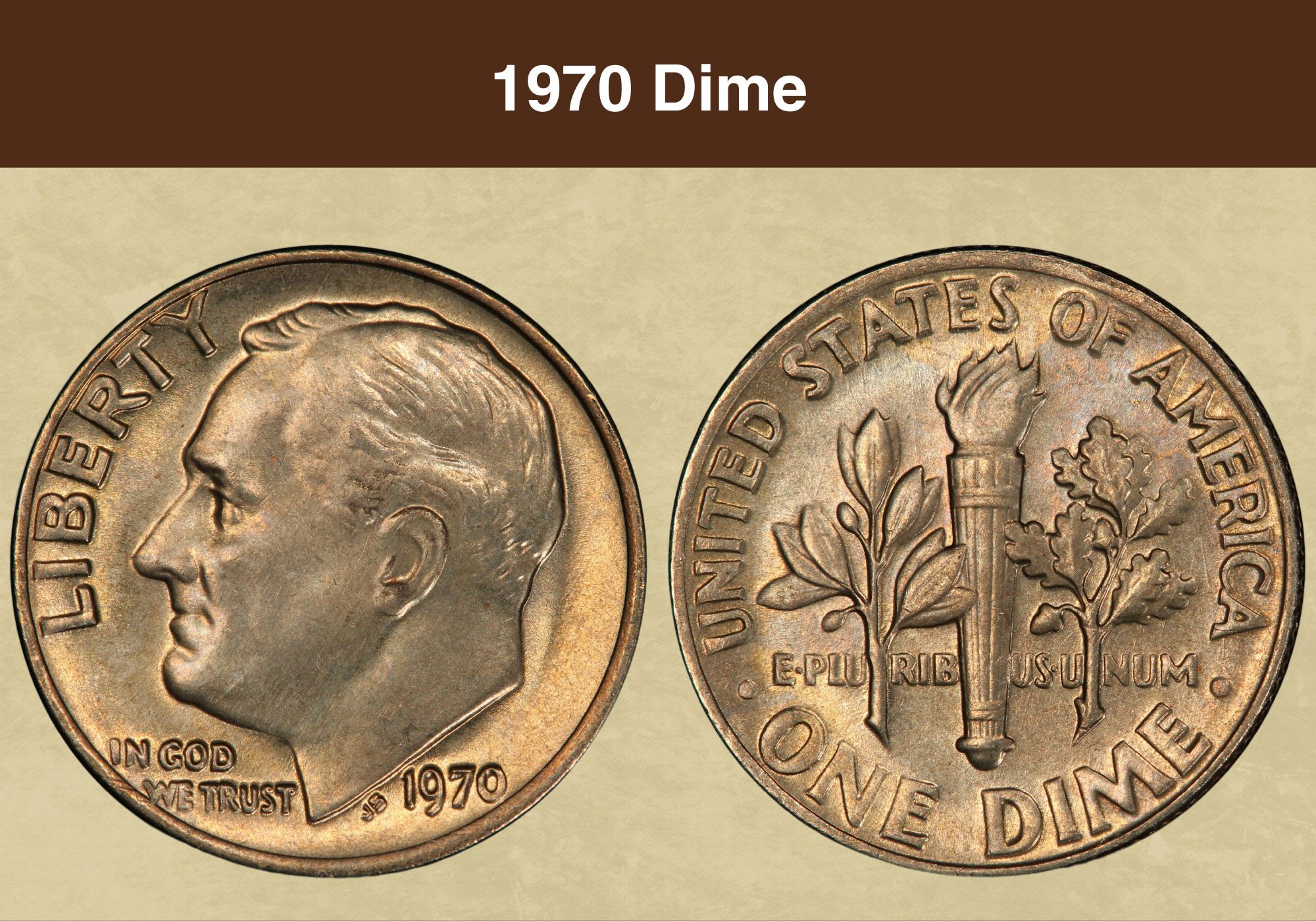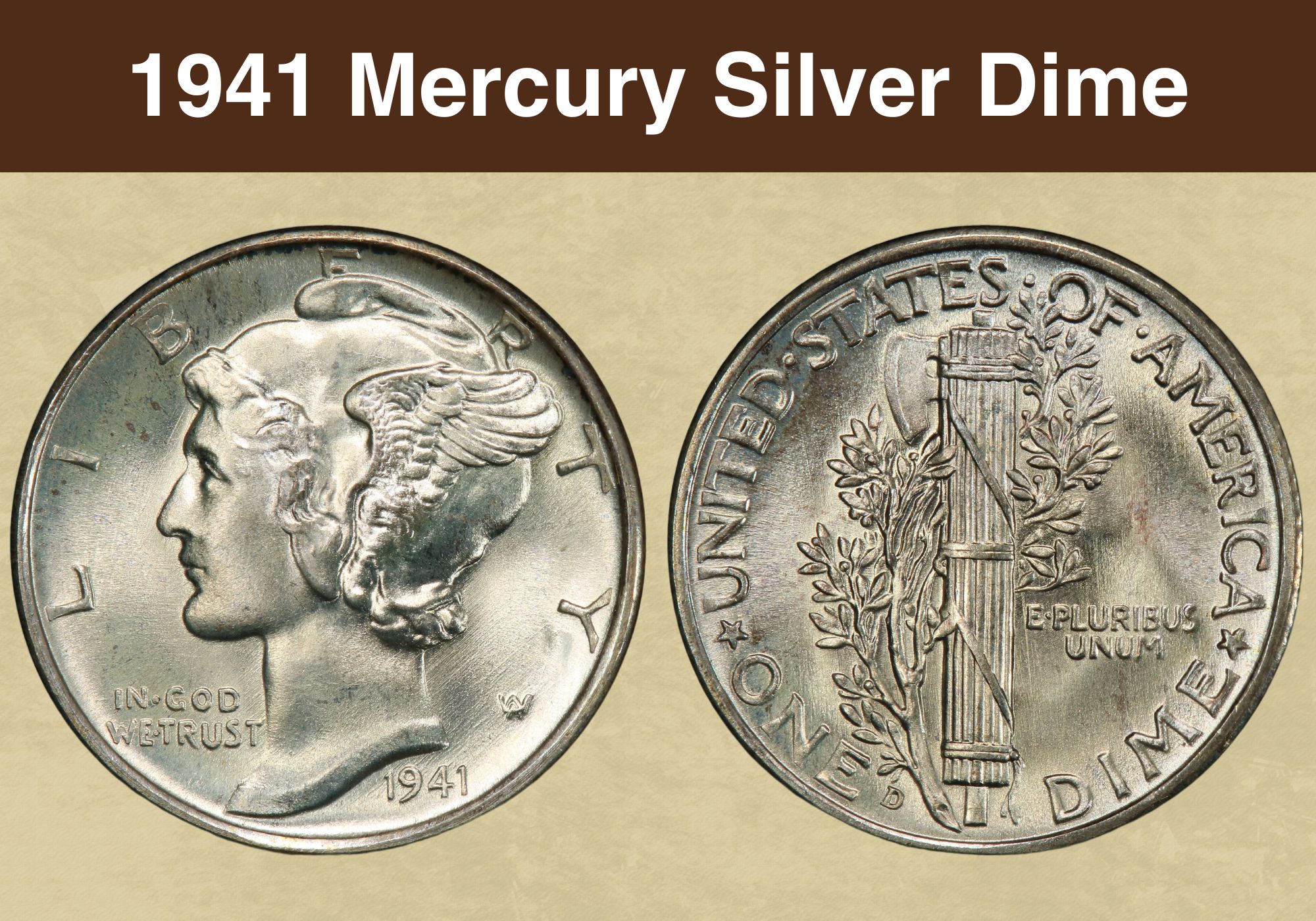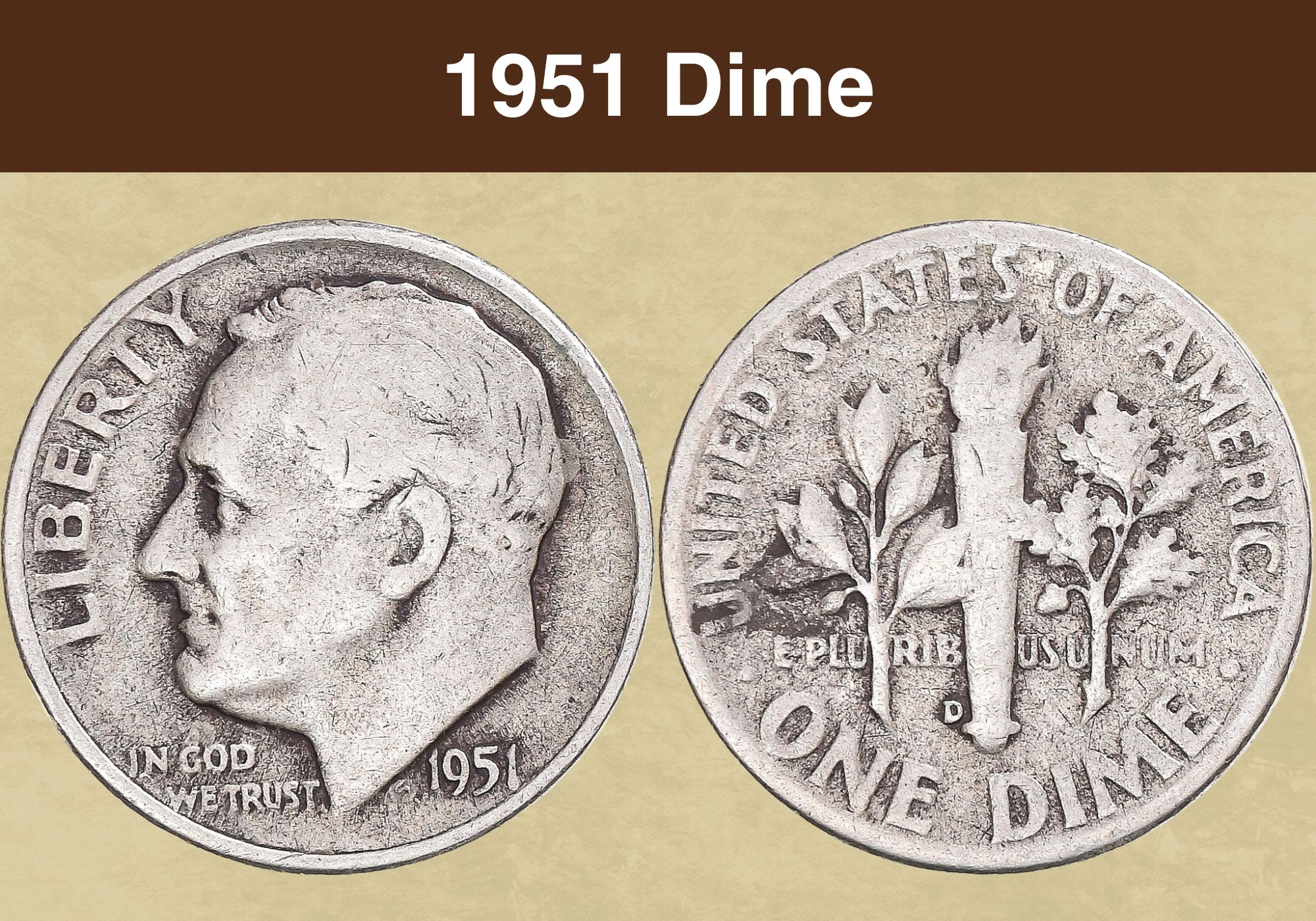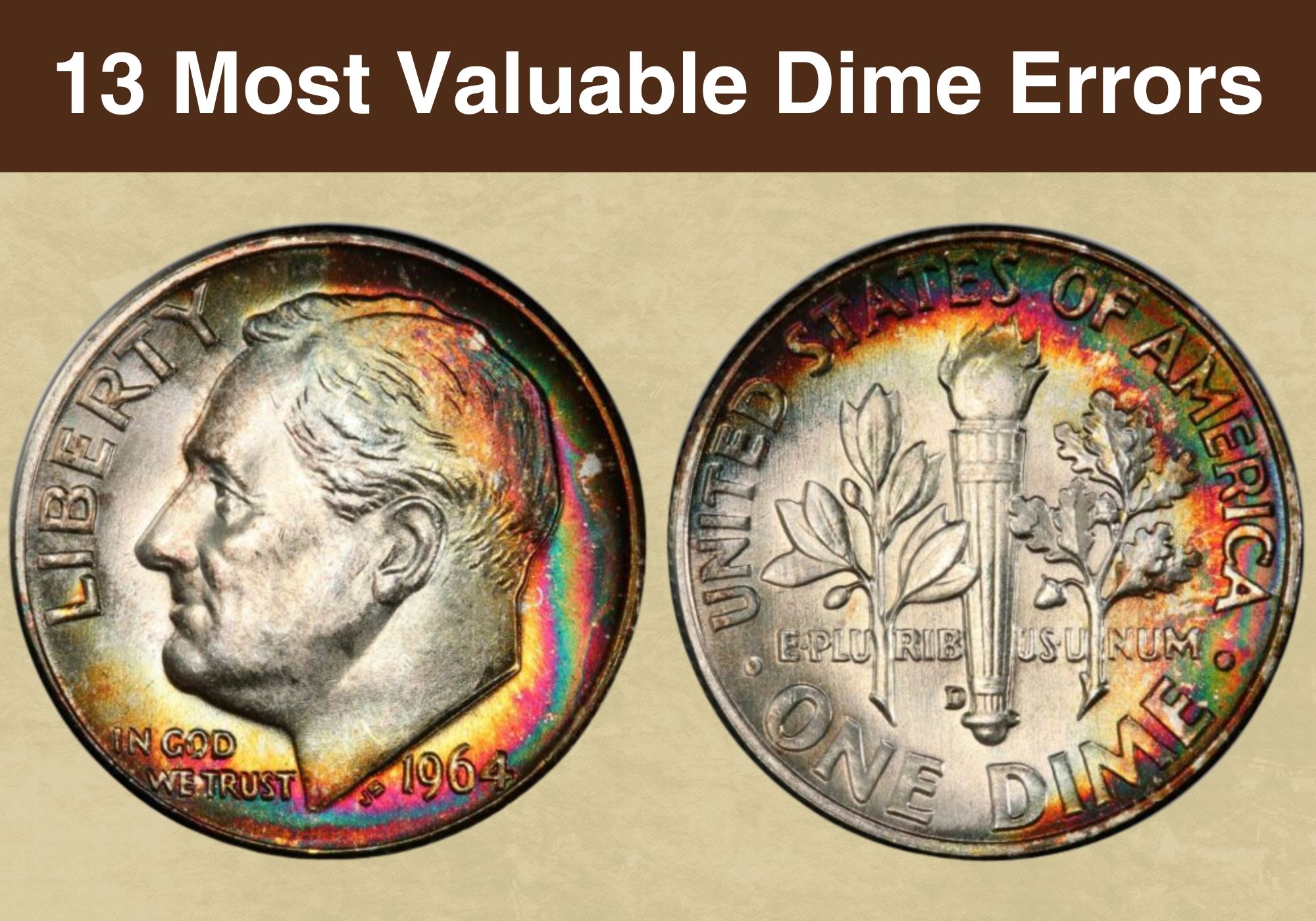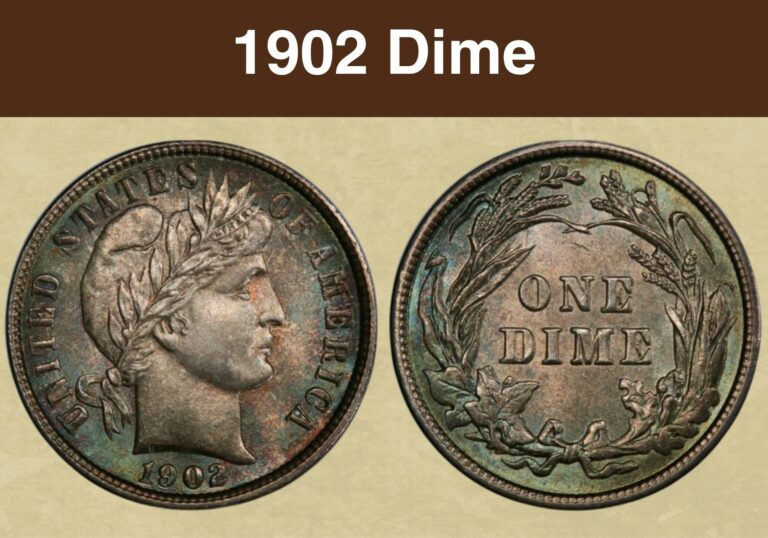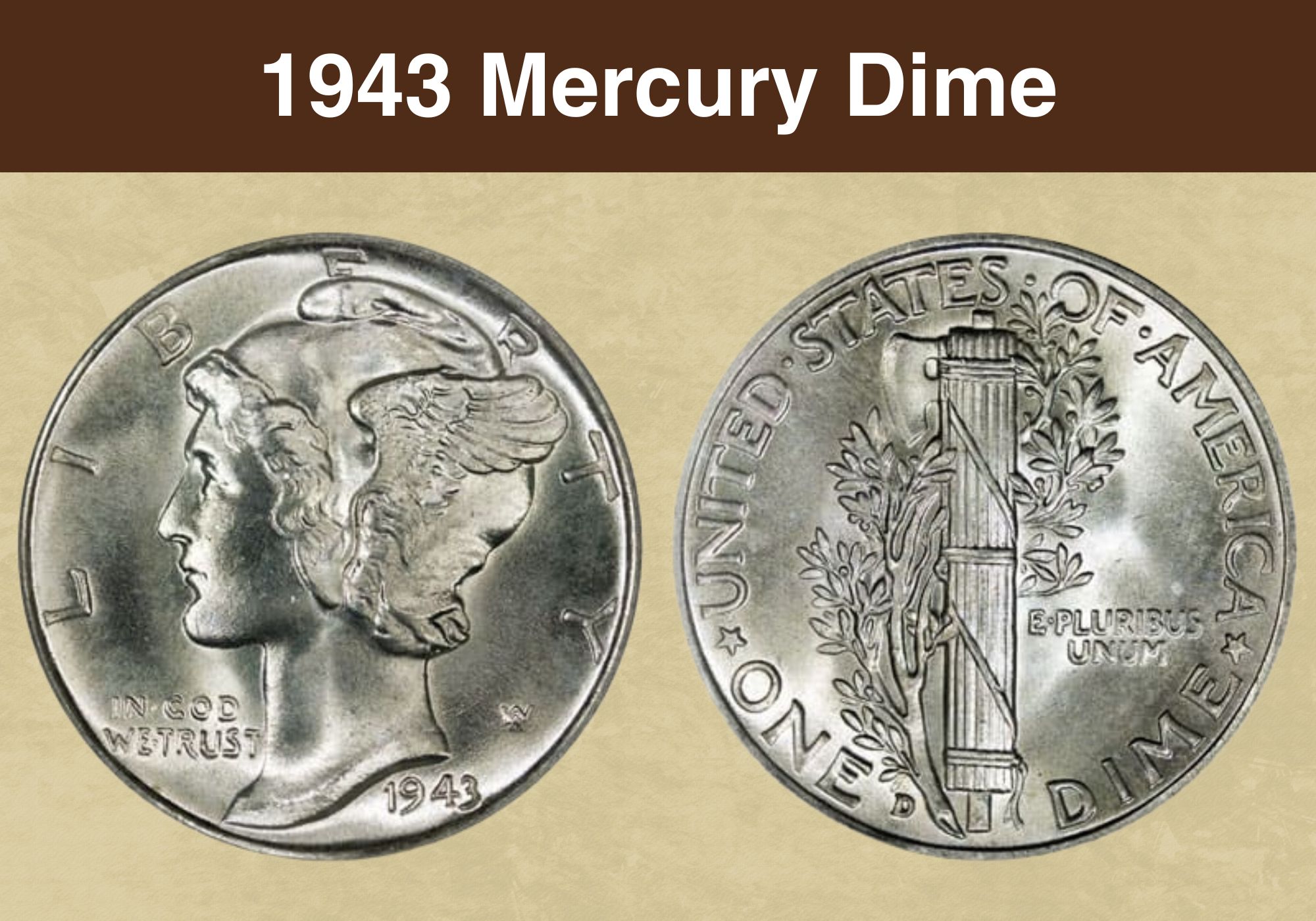
Coin Value Contents Table
The 10-cent coin struck in 1943 is often referred to as a “Mercury dime”. But how did it get its name? And how much is one of these coins worth?
We’re going to answer both these questions and more. We’ll explore the 1943 Mercury dime value and the factors that influence it. And we’ll learn about its design and history along the way.
Ready to find out more? Then read on …
1943 Mercury Dime Value Chart |
||||
| Mint mark | XF45 | MS60 | MS65 | MS68 |
| 1943 (P) No Mint Mark Dime Value | $5 | $11 | $44Full band: $62 | $450Full band: $9,250 |
| 1943 D Dime Value | $5 | $11Full band: $15 | $44Full band: $62 | $1,100Full band: $1,300 |
| 1943 S Dime Value | $5 | $11Full band: $40 | $44Full band: $100
Full band prooflike: $1,000 |
$900 Full band: $4,250 |
History of the 1943 Dime
The 1943 ten-cent coin continued the series that had begun in 1916. That year saw the launch of the “Mercury dime”, so called because of the figure on the obverse. The name, though, is a mistake – the portrait isn’t of the Roman god Mercury at all.
Although the head is wearing a winged cap, the face is very clearly that of a woman not a man. In fact, it is Lady Liberty. It was the newspapers at the time of the coin’s launch who caused all the confusion. And it persists to this day in the nickname.
The new dimes were one of several coins that were launched in 1916. New designs were produced for the quarter and half dollar too. And these all resulted from another mistake.
The Treasury believed it was necessary for coin designs to be changed after they’d been in use for 25 years. But in fact, this was wrong. The legislation in question simply gave the Treasury the power to change the coins after this period, without seeking Congressional approval.
Nevertheless, new coin designs were commissioned from the Mint. But despite these being the work of experienced engravers, they did not find favor with the Commission of Fine Arts. A competition was launched to find new designs for all three denominations.
The man chosen to redesign the dime was Adolph Weinman, already a renowned artist. He was also awarded the task of designing both sides of the half dollar.
The first decade and a half of production saw large annual mintages of Mercury dimes. But when the Great Depression set in in 1930, the need for new coins diminished. Between 1932 and 1933, no dimes were struck at all. Production resumed with gusto the following year and continued until 1945.
1943 dimes were struck at the Mint facilities at Philadelphia, Denver and San Francisco. More than 324 million coins were produced, with the Philadelphia facility accounting for more than half of the total.
Also read: Top 17 Most Valuable Roosevelt Dimes Worth Money
Features of the 1943 Mercury Dime
The Obverse of the 1943 Dime
It’s the obverse – or “heads” side – of the 1943 dime that gives it its nickname. It shows a head wearing a cap with wings. At first glance, it’s similar to classical representations of the Roman god Mercury, known as the “winged messenger”.
The first coins appeared in 1916, and the newspapers of the day wrongly identified the figure as Mercury. But the reporters must have been working to a tight deadline! Anything more than a cursory glance shows clearly that the face belongs to a woman.
It is, in fact, that stalwart of US coinage, Lady Liberty. Her portrait was the work of Adolph Weinman, and it’s generally believed to have been based on a woman named Elsie Stevens.
Elsie and her husband rented an apartment in Manhattan from Weinman. The artist, however, never confirmed the identity of his model.
Liberty is depicted in profile, facing to the left of the coin. Her hair is in curls, and the cap she wears is known as a pileus. Weinman later said that he had chosen the headgear to symbolize freedom of thought.
The portrait takes up almost the whole of the coin surface. The word “LIBERTY” arches over it, but the bottom of the letters “E” and “R” disappear behind Liberty’s head. The motto “IN GOD WE TRUST” is in small font beneath her chin.
The date is at the bottom of the coin and positioned off-center, towards the right-hand edge of the coin. Between it and the “Y” of “LIBERTY” is Adolph Weinman’s monogram.
The Reverse of the 1943 Mercury Dime
Weinman also designed the reverse of the 1943 Mercury Dime. And just as with the obverse, it has a strong classical theme.
It shows a bundle of sticks together with an axe. The bundle is bound tightly by a leather strap, and a large olive branch is wound around it.
The bundle is what’s known as a fasces. This was a weapon carried by men in ancient Rome called lictors. These were bodyguards and attendants to the Roman magistrates.
Weinman chose the fasces to represent justice, the axe war, and the olive branch peace.
The country name appears above the design, curving to run parallel to the upper coin edge. The denomination is at the bottom, parallel to the lower edge. And the two pieces of text are separated by stars, representing the states.
The motto “E PLURIBUS UNUM” is inscribed to the right of the fasces. It means “From the many, one” and is a reference to the country’s origin as a union of states.
Dimes struck in San Francisco or Denver can be identified by a mint mark on the reverse. Look for a small “S” or “D” above the “E” of “ONE”. Those produced in Philadelphia don’t have a mint mark.
Other Features of the 1943 Dime
Amongst 1943 dimes are those classified as “full band”. This refers to the strength of the strike.
To know if yours is a full band coin, you’ll need to focus on the horizontal straps around the fasces. There are three sets of these, and it’s the middle set that matters for a full band designation.
If the two middle bands have a complete, clear line running between them, the coin is a “full band” dime. And it will be worth more than a coin of the same grade without the designation.
For more information on how to identify a full band dime, take a look at this YouTube video from BigDCoins.
1943 Mercury Dime Grading
| # | Grade |
|---|---|
| 1 | Basal State-1 |
| 2 | Fair |
| 3 | Very Fair |
| 4, 5, 6 | Good |
| 7, 8, 10 | Very Good |
| 12, 15 | Fine |
| 20, 30 | Very Fine |
| 40 | Extremely Fine |
| 50 | About Uncirculated |
| 60 | Mint State |
| 65 | Mint State |
| 70 | Mint State |
Please check our grading guides to know your coin scale, It’s the necessary step to know the exact value of your coin.
Check out now: How to Grade Mercury Dime?
1943 No Mint Mark Dime Value
The Philadelphia Mint facility was particularly prolific in its production of 1943 dimes. It struck almost 192 million of them. The PCGS, an independent coin grading agency, estimates that around 10,000 survive at all grades.
The value of an individual coin will depend on its condition, including whether it has the full band designation. Coins are graded from 1 to 70, with 1 being the lowest and 70 the best.
A 1943 Philadelphia dime graded XF45 (the letters stand for “extremely fine”) will be worth around $5.
Prices for coins in uncirculated condition are higher. These start at $11 for an MS60 example (“MS” stands for “mint state”).
Full band coins, by definition, only exist in higher grades. The lowest grade recorded for a full band 1943 Philadelphia dime is MS61. The PCGS values a coin at that level at $20, compared to $12 for a coin of the same grade without the full band.
Coins graded MS65 and above are known as gems and are more expensive. At MS65, a coin without the full band designation is worth $44. A full band increases that value to $62.
Values for full band 1943 Philadelphia dimes breach four figures at MS67+ ($1,075). And there’s a big leap in value for the very top grades.
The PCGS has certified 14 coins at MS68, with each one valued at $9,250. And the finest of all are two coins graded MS68+. Those are each worth a stonking $16,500.
1943 D Mercury Dime Value
Less than half as many dimes were struck in Denver than Philadelphia in 1943. Despite this, more Denver dimes have survived the intervening years. Today, the PCGS estimates that 20,000 remain at all grades – twice as many as Philadelphia dimes.
Nevertheless, at most grades, values are identical. A 1943 Denver dime graded XF45 is worth about $5. That rises to $11 for an MS60 example, and to $20 for a coin at the same grade with a full band.
A Denver mint mark does, however, offer a premium at some grades. An MS68 1943 Denver dime without the full band designation is worth $1,100. That’s well over twice as much as the Philadelphia equivalent. The reason is that only one coin has so far been certified by the PCGS at this level.
But for the finest full band coins, Denver coins are worth less than Philadelphia ones. Almost 60 Denver 1943 dimes have been certified at MS68, keeping their value to a modest $1,300. Philadelphia dimes at the same grade are worth almost ten times more.
Quality tops out at MS68+, with seven coins certified at that level. The PCGS values those at $14,000 apiece, compared to $17,500 for Philadelphia dimes of the same quality.
1943 S Dime Value
The San Francisco Mint facility struck over 60 million dimes in 1943. These can be identified by the “S” mint mark on the obverse.
Values for circulated coins are roughly the same as for Denver and Philadelphia examples. They range from $4 for a coin graded 3, to $10 for an “about uncirculated” example graded AU58+.
Mint state coins without the full band designation can be yours for between $11 (MS60) and $900 (MS68). Full band dimes range from $30 at MS62 to $7,750 for a sole coin graded MS68+.
But the finest of all the 1943 San Francisco dimes are those classified as “full band, prooflike”. No proof dimes were manufactured that year, and the San Francisco facility was the only one to produce prooflike examples.
They’re available in grades between MS65 and MS67+. They’re highly sought after by collectors, and values range from $1,000 to $4,250.
Also read: Top 17 Most Valuable Mercury Dimes Worth Money
Rare 1943 Mercury Dime Error List
1943 S Mercury Die, Broadstruck
The planchet – the metal disc on which the coin design is stamped – is supposed to be held in place by a collar as it’s struck. But sometimes, the planchet isn’t held securely.
When that happens, the metal can expand beyond the collar when it’s struck. That creates a larger coin with a blank area around the edge. This type of error is known as a “broadstruck” coin.
One 1943 dime in San Francisco was broadstruck. The blank area appeared on the right as the coin was viewed.
It was otherwise in great condition. It had been graded MS64 and designated “full band” by the independent coin graders, the NGC. It sold at auction for $120.
1943 S Re-punched Mint Mark
Some of the dimes that came out of the San Francisco Mint facility in 1943 have a re-punched mint mark. View them up close with a microscope or loupe, and you’ll see the shadow of a second “S” alongside the first.
This error type is coded FS-501, and it adds a premium to coin values. A 1943 S dime with this error will be worth around $250 at MS63, rising to $485 at the highest known grade, MS65+.
Check out this YouTube video from Couch Collectibles to see examples of both these errors and more.
Also read: 13 Most Valuable Dime Errors Worth Money
Where to Sell Your 1943 Dime ?
Now that you know the value of your coins, do you know where to sell those coins online easily? Don’t worry, I’ve compiled a list of these sites, including their introduction, pros, and cons.
Check out now: Best Places To Sell Coins Online (Pros & Cons)
FAQs
How much is a 1943 Mercury Head dime worth?
That depends on the quality and condition of the coin.
Value increases with coin grade, measured from 1 to 70. And coins with the “full band” designation are worth more than those without.
The designation refers to the design on the reverse. Look at the horizontal bands around the middle of the bunch of sticks that appears there. There are two of them, one on top of the other. If there’s a complete and clear line all the way between them, it’s a full band coin.
Mint errors can add value to coins too.
A standard circulated 1943 Mercury Head dime in poorer condition will be worth only a few dollars. But the “best in class” examples can be worth tens of thousands.
Is a 1943 Mercury Head dime rare?
At most grades, Mercury Head dimes aren’t rare. But in grades higher than MS66, they are much harder to find – and that makes them more valuable.
Mint errors like broadstruck coins or those with repunched mint marks are, by definition, relatively rare too.
The quality and condition of the coin will usually be the main factors in determining its value. But the presence of a Mint error will add a premium to its value.

